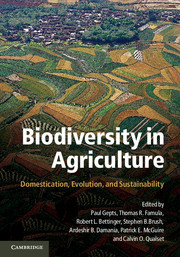Book contents
- Frontmatter
- Contents
- Tables
- Figures
- Foreword
- Contributors
- Acknowledgments
- Introduction: The Domestication of Plants and Animals: Ten Unanswered Questions
- 1 The Local Origins of Domestication
- Section I Early Steps in Agricultural Domestication
- Section II Domestication of Animals and Impacts on Humans
- 9 Pathways to Animal Domestication
- 10 Genetics of Animal Domestication
- 11 Genome-Wide Approaches for the Study of Dog Domestication
- 12 Malaria and Rickets Represent Selective Forces for the Convergent Evolution of Adult Lactase Persistence
- Section III Issues in Plant Domestication
- Section IV Traditional Management of Biodiversity
- Section V Uses of Biodiversity and New and Future Domestications
- Index
- References
9 - Pathways to Animal Domestication
Published online by Cambridge University Press: 05 June 2012
- Frontmatter
- Contents
- Tables
- Figures
- Foreword
- Contributors
- Acknowledgments
- Introduction: The Domestication of Plants and Animals: Ten Unanswered Questions
- 1 The Local Origins of Domestication
- Section I Early Steps in Agricultural Domestication
- Section II Domestication of Animals and Impacts on Humans
- 9 Pathways to Animal Domestication
- 10 Genetics of Animal Domestication
- 11 Genome-Wide Approaches for the Study of Dog Domestication
- 12 Malaria and Rickets Represent Selective Forces for the Convergent Evolution of Adult Lactase Persistence
- Section III Issues in Plant Domestication
- Section IV Traditional Management of Biodiversity
- Section V Uses of Biodiversity and New and Future Domestications
- Index
- References
Summary
Jack Harlan was a polymath. His life-long study of crop evolution combined plant sciences, archaeology, systematics, genetics, and conservation, leaving a legacy of five decades of influential publications that explored all aspects of crop plants – their origins, their dispersal, and their continued and future role in supporting the Earth's burgeoning populations. To Harlan, agriculture was not an invention or the product of a single big idea. Instead, he saw agricultural origins in terms of a long co-evolutionary process involving humans and plants that grew out of “many independent tentatives in many locations that fused over time to produce effective food production systems” (Harlan 1995). Harlan's remarkable body of published work contains only one short encyclopedia entry on the subject of animal domestication (Harlan 1994). He was, in fact, somewhat dismissive of the contribution of animal domesticates to humankind's food supply stating that “(a)nimals are not essential, plants supply over 90% of the food consumed by humans” (Harlan 1995). Jack Harlan would likely agree, however, that understanding livestock evolution requires the same breadth of focus that he brought to the study of crop evolution. Here I follow Harlan's example in a consideration of domestic animals, bringing together information from animal sciences, genetics, and archaeology to explore the multiple pathways leading to animal domestication and the implications of these pathways for current and future relationships between humans and their animal partners.
Domestication as a process
All considerations of domestication, whether focusing on crops or livestock, acknowledge that it involves a two-way relationship between humans and target plant or animal populations. There is less unanimity in different conceptual approaches to domestication on whether emphasis should be placed on the human or the plant/animal side of the equation (see Zeder 2006a). Some cast humans as the dominant partner in a relationship in which humans consciously and with deliberate intent assume “mastery” over all aspects of the production, movement, feeding, and protection of the domesticate (Hale 1969, Ducos 1978, Bökönyi 1989, Clutton-Brock 1994). Others see domestication as a form of biological mutualism in which both partners (humans and domesticate) reap benefits (O'Connor 1997). Some even contend that domesticates manipulated unwitting humans into relationships that gave the domesticate great evolutionary advantage at the expense of human fitness (Rindos 1984, Budiansky 1992, Morey 1994).
- Type
- Chapter
- Information
- Biodiversity in AgricultureDomestication, Evolution, and Sustainability, pp. 227 - 259Publisher: Cambridge University PressPrint publication year: 2012
References
- 157
- Cited by



